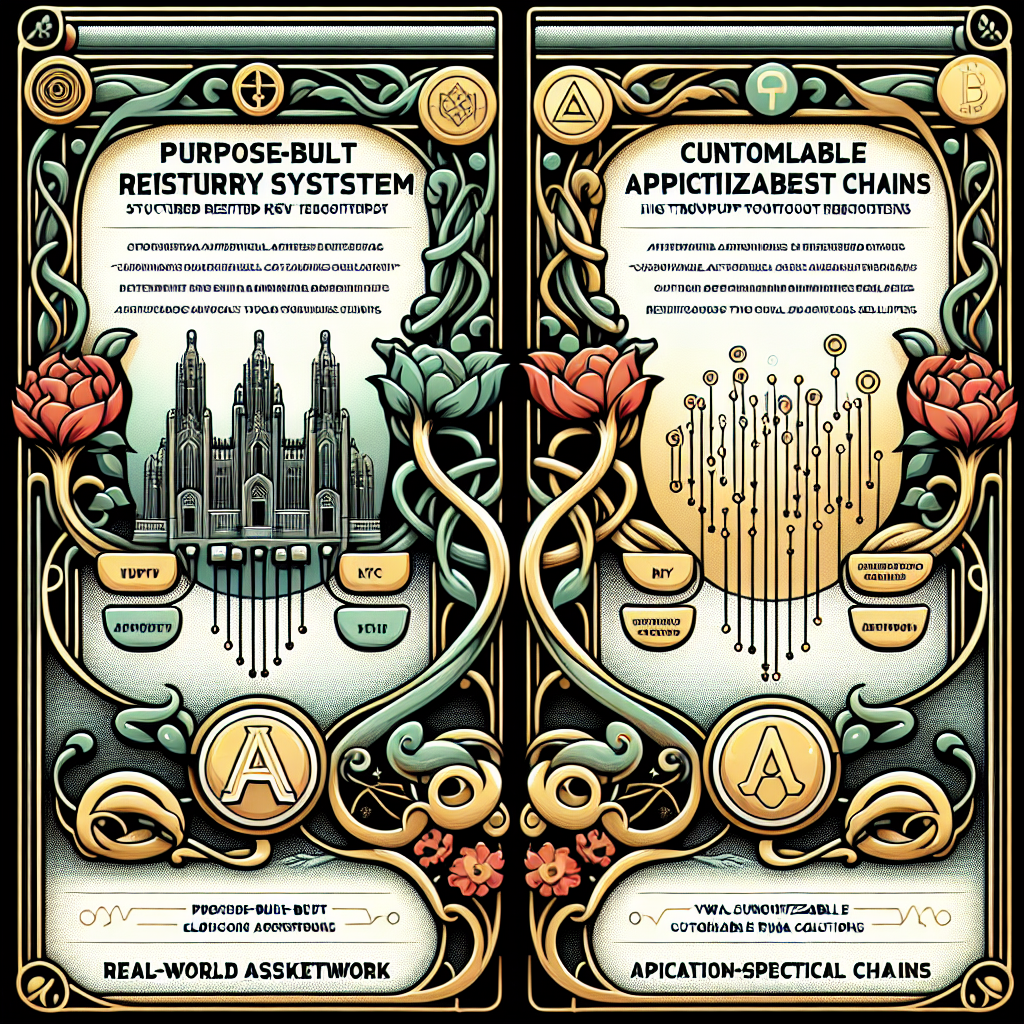Purpose-Built vs. Customizable: Comparing RedBelly and Aurora Solutions for RWA Issuers

The Rise of Specialized Blockchain Infrastructure for Real World Assets
As the tokenization of real-world assets (RWAs) evolves from experimental projects to institutional adoption, the blockchain infrastructure supporting these initiatives must evolve as well. Generic public blockchains, designed primarily for cryptocurrency transactions, increasingly fall short of meeting the specific requirements that RWA issuers demand.
The market is now witnessing the emergence of two distinct approaches to solving this problem: purpose-built networks specifically designed for RWA issuance and customizable application-specific chains that can be tailored to meet issuer requirements. Today, we'll examine two leading solutions representing each approach: RedBelly Network and Aurora.
And before you ask – no, neither of these solutions involves putting your grandmother's antique silver on a blockchain. Though I must admit, some of her jewelry could benefit from immutable proof-of-authenticity. But I digress...
The Purpose-Built Approach: RedBelly Network
RedBelly Network represents the purpose-built approach to RWA tokenization – a blockchain network designed from the ground up specifically for the compliant tokenization of real-world assets.
Key Features of RedBelly's Solution
- Built-in KYC/AML Verification: RedBelly incorporates zero-knowledge proofs (ZKP) and verifiable credentials directly into the protocol, creating a seamless yet compliant experience for users without repetitive KYC processes.
- Digital Registries: The network enables issuers to create a single source of truth for entire asset classes on-chain, ensuring transparency and accountability.
- Extraordinary Performance: Utilizing patented Superblock scalability technology, RedBelly processes up to 97,500 transactions per second with instant finality – orders of magnitude beyond most public blockchains.
- Leaderless Consensus: The Democratic Byzantine Fault Tolerant (DBFT) consensus mechanism guarantees a unique blockchain branch, eliminating the risk of chain reorganizations that could wreak havoc on RWA transactions.
- Protocol-Level Compliance: Support for major regulatory standards including FATF Travel Rule and MiCA is built directly into the protocol itself.
In essence, RedBelly offers a high-performing public blockchain with KYC and compliance baked into its architecture. It's akin to a purpose-built factory with specialized machinery designed exclusively for manufacturing one specific type of product – highly efficient, but with a narrower focus.
The Customizable Approach: Aurora
In contrast, Aurora takes a different path by offering fully customizable, application-specific L2 chains built on the NEAR protocol. This approach prioritizes flexibility and developer choice.
Key Features of Aurora's Solution
- Customizable Virtual Chains: Aurora's architecture supports both public and private chain deployments, allowing issuers to determine their exact requirements.
- Gasless Transactions: Aurora supports gasless transaction models, significantly reducing costs compared to Ethereum, with transaction fees averaging a mere $0.003.
- EVM Compatibility: Full compatibility with the Ethereum Virtual Machine allows seamless porting of existing Ethereum-based tools and smart contracts.
- Rainbow Bridge Technology: Facilitates interoperability between NEAR, Aurora, and Ethereum ecosystems.
- Custom Token Mechanics: Aurora Silos allow for bespoke token economics tailored to specific asset classes and business models.
- Controlled Environment: Issuers can determine who has permission to deploy smart contracts, ensuring tight control over their chain environment.
Aurora's approach is more akin to providing a customizable workspace where each issuer can build their own specialized environment – perhaps not as turnkey as RedBelly's solution, but offering greater flexibility for unique requirements.
And much like how I customize my morning coffee ritual (three beans from Guatemala, two from Ethiopia, ground precisely at 6:42 AM while listening to Bach), Aurora lets asset issuers fine-tune every aspect of their blockchain infrastructure. Though thankfully with fewer coffee grounds spilled on the counter.
Comparing Solutions: Which Approach Suits Different Issuers?
| Consideration | RedBelly Network | Aurora |
|---|---|---|
| Time to Market | Faster – purpose-built solution ready to use | Longer – requires custom chain configuration |
| Flexibility | Lower – predetermined compliance framework | Higher – fully customizable environment |
| Performance | Exceptional – 97,500 TPS with instant finality | Very good – ~1 second blocks, ~2 second finality |
| Compliance | Predetermined and built-in | Customizable to specific requirements |
| Development Resources | Lower – use existing infrastructure | Higher – configure custom environment |
Ideal Use Cases
When RedBelly Shines
RedBelly's purpose-built approach is particularly well-suited for:
- Asset issuers requiring immediate deployment with standardized compliance
- Projects dealing with high-volume, high-frequency transactions
- Issuers operating across multiple jurisdictions who benefit from standardized compliance
- Teams with limited blockchain development resources
When Aurora Takes the Lead
Aurora's customizable approach excels for:
- Issuers with highly specific or unique compliance requirements
- Projects needing tight control over who can deploy contracts
- Issuers wanting to create novel token mechanics specific to their asset class
- Teams with strong development resources who value flexibility above all
- Projects requiring seamless integration with existing Ethereum infrastructure
The Future of RWA Infrastructure
The emergence of these specialized RWA solutions signals a maturing tokenization ecosystem. As institutional adoption increases, expect to see further specialization across the blockchain landscape, with more purpose-built and customizable solutions targeting specific RWA categories.
The divide between purpose-built and customizable approaches will likely persist, as each addresses different priorities for issuers. However, we may eventually see hybrid approaches that combine the turnkey convenience of purpose-built solutions with some degree of customizability.
What's clear is that the era of forcing RWA issuance onto general-purpose blockchains is coming to an end. As traditional finance increasingly embraces tokenization, the infrastructure supporting these assets must evolve to meet the specific requirements of institutional issuers.
Conclusion: No One-Size-Fits-All Solution
The choice between RedBelly's purpose-built approach and Aurora's customizable framework ultimately depends on an issuer's specific priorities, resources, and requirements. Both solutions represent significant advances over general-purpose blockchains for RWA issuance.
For issuers prioritizing rapid deployment, standardized compliance, and exceptional performance, RedBelly offers an attractive turnkey solution. For those valuing flexibility, customizability, and control above all, Aurora's approach may prove more suitable.
As with most things in life – except perhaps my unwavering commitment to perfectly toasted sourdough – there's no absolute right answer. The beauty of today's evolving RWA infrastructure is that issuers finally have meaningful choices tailored to their specific needs.
And in a world where your grandchildren might one day inherit tokenized shares of a commercial real estate portfolio rather than physical property deeds, having the right infrastructure in place becomes increasingly crucial.




